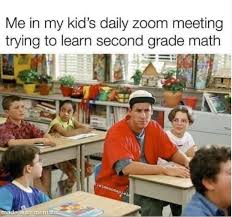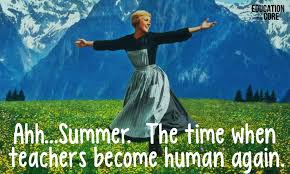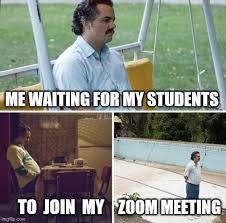Image Source: Education to the Core
Hey there, fellow meme enthusiasts and aspiring scholars! Welcome to the craziest classroom on the internet - where memes meet education! 😄
Before memes became an integral part of our daily digital diet, they were like the secret handshake of the internet. You know, the kind of thing only the cool kids in the digital playground knew about. But then, bam, along came social media, and memes exploded onto the scene like glitter at a disco party.
It all started with primitive memes like "Dancing Baby" and "Hamster Dance" back in the dial-up days of the early 2000s. These precursors were the Chuck Berry and Elvis of the meme world, laying the groundwork for what was to come. But it was social media platforms like Facebook, Twitter, and Instagram that turned memes into the rockstars of the internet.
So we all know memes can be used to convey multiple messages. Let's have a look at some members of the meme hall of fame and see if we can come up with some potential learning messages for each.
Distracted Boyfriend Meme:

Potential Learning Messages:
Infidelity and Temptation: The meme often represents the idea of temptation and infidelity. The distracted boyfriend's wandering eye symbolizes the allure of something new or different, while the girlfriend's disapproval reflects the consequences of straying from a committed relationship.
Decision-Making and Choices: The meme can be used to discuss decision-making and choices in life. It highlights how people are often presented with multiple options and must make decisions that may have both positive and negative outcomes.
Fickleness of Human Nature: It humorously illustrates how humans can be fickle and easily distracted by novelty. People might relate to situations where they've been drawn to new opportunities or experiences, even when they have existing commitments.
Social Commentary: The meme can be used to comment on social or political issues. For example, the distracted boyfriend can represent a society that is constantly seeking the next big thing, neglecting important issues or commitments.
Pop Culture References: It's not uncommon for this meme to be adapted to reference specific pop culture events or trends. It can be used to humorously comment on the ever-changing landscape of popular culture.
Career Choices: In an educational context, the meme can be used to discuss career choices and opportunities. The boyfriend's choice to look at another job opportunity while in a current job can symbolize the challenges and decisions people face in their careers.
Ethics and Morality: The meme can serve as a starting point for discussions about ethics and morality. Is it ethical to be drawn to something new while neglecting existing responsibilities or commitments?
Personal Growth and Learning from Mistakes: It can also be used to emphasize the importance of personal growth and learning from one's mistakes. The distracted boyfriend's behavior might lead to negative consequences, highlighting the need to reflect on actions and their consequences.
Marketing and Brand Loyalty: In marketing and advertising, the meme can be used to explore brand loyalty and the strategies companies use to attract customers away from their competitors.
Relationship Dynamics: Finally, it can be a fun way to discuss relationship dynamics, jealousy, and communication within partnerships. The meme's characters represent common relationship challenges and dynamics in a humorous manner.
Two Buttons Meme:

Potential Learning Messages:
Ethical Dilemmas: The meme often represents ethical dilemmas where individuals are faced with a difficult choice. It can be used to discuss moral decision-making, right versus wrong, and the complexities of ethical issues.
Decision-Making and Consequences: It highlights the consequences of decisions. Pressing one button may lead to positive outcomes, while the other may result in negative consequences. This can be used to teach critical thinking and the concept of cause and effect.
Personal Choices: The meme can be applied to personal life choices and decision-making processes. It encourages reflection on the potential outcomes of one's choices and the importance of making informed decisions.
Risk Assessment: It can be used to discuss risk assessment and risk management. Individuals must evaluate the potential risks and benefits associated with each button before making a choice.
Complex Problem-Solving: The meme can serve as a metaphor for complex problem-solving. In some scenarios, neither "Yes" nor "No" may seem like the correct choice, highlighting the need for creative solutions.
Political and Social Commentary: It's often adapted for political or social commentary. The buttons can represent policy decisions, political choices, or societal issues. It allows for a humorous take on serious topics.
Humor and Satire: The meme's simplicity can be used for humor and satire. It often employs absurd or exaggerated choices to create comedic scenarios.
Game Theory: It introduces the concept of game theory, where individuals must make decisions while considering the choices and potential actions of others. This can lead to discussions about strategy and optimal decision-making.
Consent and Boundaries: In some adaptations, the meme can be used to discuss consent and boundaries in relationships. It highlights the importance of respecting others' choices and autonomy.
Social Pressures: The meme can be applied to situations where individuals feel pressured to conform or make choices based on societal expectations. It encourages discussions about individual agency.
Philosophical Debates: It can be used to introduce philosophical debates, such as utilitarianism versus deontology. Which button is the morally right choice, and why?
Business and Marketing Decisions: In business and marketing contexts, the meme can represent decision-making related to product launches, marketing strategies, and investment choices.
Technology and Innovation: It can be adapted to discuss technological advancements and innovation. Which path leads to progress, and which might have unintended consequences?
Woman Yelling at a Cat Meme:

Potential Learning Messages:
Conflict and Resolution: The meme can be used to illustrate conflicts and the need for resolution. The woman represents someone expressing strong emotions, while the unresponsive cat symbolizes the need for calm and rational dialogue in resolving disputes.
Misunderstandings: It can be applied to situations where misunderstandings occur. The woman's intensity can represent a passionate but misguided perspective, while the cat's indifference can symbolize the importance of clarifying intentions and perspectives.
Communication Breakdown: The meme can highlight the consequences of poor communication. The woman's frustration can represent the breakdown of effective communication, emphasizing the need for clarity and active listening.
Debates and Arguments: It humorously captures the essence of debates and arguments. The woman's argumentative stance and the cat's nonchalant response can serve as a humorous commentary on the nature of disagreements.
Internet Culture: It can be used to comment on internet culture, where passionate arguments often unfold online. The meme's popularity is a testament to how internet users engage in debates and discussions, sometimes with humorous results.
Generation Gap: In some adaptations, the meme can represent generational differences and the challenges of understanding perspectives from different age groups or backgrounds.
Relatability and Everyday Frustrations: It can be relatable in everyday situations where people encounter frustrating or nonsensical situations. The meme provides a humorous way to vent about common annoyances.
Resilience and Stoicism: The cat's calm demeanor can symbolize resilience and stoicism in the face of adversity or criticism. It can encourage discussions about maintaining composure in challenging situations.
Assertiveness vs. Passivity: The meme can explore the balance between assertiveness and passivity in communication. When is it appropriate to express strong feelings, and when is it better to remain calm and composed?
Cultural and Political Commentary: It's often adapted for cultural and political commentary, with the woman representing a specific ideology or viewpoint and the cat representing a contrasting perspective.
Humor and Irony: The meme relies on humor and irony, where the intensity of the woman's expression contrasts with the cat's seemingly uninterested demeanor. It's a humorous way to depict contrasting reactions.
Relationship Dynamics: In some adaptations, the meme can symbolize dynamics in relationships, such as the contrast between someone seeking emotional engagement and another person appearing emotionally distant.
Mocking SpongeBob Meme:

Potential Learning Messages:
Mockery and Ridicule: The primary message of the meme is to mock or ridicule someone or something in a playful and exaggerated manner. It's often used to express sarcasm and jest.
Reaction to Absurdity: It can be applied when confronted with absurd or nonsensical statements or actions. The distorted text represents a reaction to something that is difficult to take seriously.
Exaggeration of Emotion: The meme amplifies emotions and reactions for comedic effect. It can be used to humorously emphasize how something is either "the best thing ever" or "the worst thing ever."
Disbelief and Disapproval: The alternating text can be seen as a reaction of disbelief or disapproval when confronted with unconventional or irrational ideas or behaviors.
Internet Culture: The meme is often used to mock internet trends, phrases, or behaviors. It highlights how internet users may react sarcastically to popular or overused online content.
Commentary on Trends: It can be used to comment on trends and fads, both online and offline. The meme often reflects a sense of exhaustion with trends that are perceived as repetitive or absurd.
Critique of Hypocrisy: It can serve as a critique of hypocrisy or double standards. The alternating text can express a sense of irony when someone contradicts themselves or behaves hypocritically.
Social Commentary: The meme can be adapted for social commentary on a wide range of topics, from politics to pop culture. It provides a humorous way to express frustration or disagreement with prevailing views.
Response to Annoyance: It can represent a response to annoying or frustrating situations. The alternating text captures the exasperation one might feel when dealing with such situations.
Humor and Irony: The meme relies heavily on humor and irony, with the distorted text providing a visually amusing way to convey a reaction.
Cultural References: It can be used to reference and mock specific cultural phenomena, trends, or stereotypes. The meme adapts easily to various cultural contexts.
Personal Expression: Individuals often use the meme to express their personal reactions to different situations, adding their own text to convey their thoughts and feelings.
Parody and Satire: It can be employed as a form of parody or satire, particularly when mocking specific individuals, organizations, or ideologies.
Meme Within a Meme: The meme can be used to parody other memes or trends, creating layers of humor and commentary.
Creative Expression: Users often get creative with the meme, altering the text and image to convey specific messages, jokes, or references.
This Is Fine Dog Meme:

Potential Learning Messages:
Coping with Stress and Chaos: The central message of the meme is the idea of coping with stress, chaos, or overwhelming situations by downplaying or ignoring the severity of the problem. It's often used to express a sense of resignation in the face of adversity.
Acceptance of the Uncontrollable: The meme can symbolize acceptance of circumstances that are beyond one's control. It conveys the idea that sometimes, all you can do is accept the situation and find a way to deal with it, even if it seems dire.
Denial and Avoidance: It can represent the human tendency to deny or avoid addressing uncomfortable truths or difficult situations. The dog's nonchalant attitude can be seen as a humorous exaggeration of this behavior.
Critique of Inaction: The meme can serve as a critique of inaction in the face of problems. It highlights the consequences of not taking action when action is needed.
Procrastination and Delay: It can be applied to situations where individuals procrastinate or delay addressing important issues. The meme illustrates the potential consequences of ignoring problems until they become unmanageable.
Social Commentary: The meme is often adapted for social and political commentary, illustrating how people and institutions may respond to crises with indifference or ineffective solutions.
Office Culture: It has been used to humorously depict office culture and the tendency to ignore workplace issues or inefficiencies.
Climate Change and Environmental Issues: The meme has been adapted to comment on environmental concerns, particularly regarding climate change and the failure to take action despite visible signs of crisis.
Online Discourse: It can be used to comment on online discussions or debates, where individuals may dismiss or downplay serious issues with humor or sarcasm.
Personal Resilience: The meme can symbolize personal resilience in the face of adversity. It conveys the idea that even in dire situations, one can maintain a sense of humor and optimism.
Existentialism: It has been interpreted in an existential context, highlighting the human experience of navigating a seemingly absurd and indifferent world.
Satire and Irony: The meme relies on satire and irony, with the dog's expression of "this is fine" contrasting sharply with the obviously chaotic and dangerous situation.
Internet Culture: It has become a symbol of internet culture, representing how internet users may respond to online drama or crises with a sense of detachment and humor.
Normalization of Problems: The meme can be used to criticize the normalization of problems or crises in society, where people become desensitized to ongoing issues.
So as you can see the possibilities are endless! This is part and parcel why the meme is such a widely used method for conveying messages nowadays. As educators, we must learn to adapt to the times and meet our learners where they learn - our attitudes or opinions be damned!
Now, you may be wondering, how can educators find the right memes to create an emotional connection with their students? Well, it's time to put on your meme detective hat!
Know Your Audience: Just like any good teacher, you need to understand your students. What memes resonate with them? Are they into pop culture, science, or history? Tailor your memes accordingly.
Stay Current: Memes have a notoriously short lifespan. Be aware of what's trending, but don't be afraid to use classic memes either. They're like the Shakespeare of the meme world.
Use Humor Wisely: Memes are funny, but they shouldn't undermine the seriousness of the subject matter. Humor can be a powerful teaching tool, but it should always serve the learning objective.
Be Inclusive: Ensure that the memes you choose are inclusive and considerate of diverse backgrounds and perspectives. Memes should never be exclusionary or offensive.
Create a Meme Library: Building a collection of memes related to your subject can be a valuable resource. Organize them by topic and be ready to deploy the perfect meme when the moment strikes.
So, there you have it! Memes aren't just for procrastination; they're the unsung heroes of education, adding a dash of humor and relatability to the learning process.
Unsure about how to use memes in your learning materials? Well don't worry, we won't leave you feeling like John Travolta in Pulp Fiction...
See how easy that was? Be sure to reach out to us at Onward Learning Solutions via our contact form and we can make sure you're using the right memes to create fun and engaging learning for your audience.
Remember, memes are like the icing on the cake of knowledge - they make it all the more delicious! But use them wisely, because with great memes come great responsibility.
Now go forth, intrepid educators, and meme your way to enlightenment! 🚀






Comments